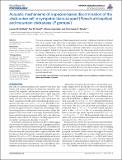Acoustic mechanisms of a species-based discrimination of the chick-a-dee call in sympatric black-capped (Poecile atricapillus) and mountain chickadees (P. gambeli)
Abstract
Previous perceptual research with black-capped and mountain chickadees has demonstrated that these species treat each other’s namesake chick-a-dee calls as belonging to separate, open-ended categories. Further, the terminal dee portion of the call has been implicated as the most prominent species marker. However, statistical classification using acoustic summary features suggests that all note-types contained within the chick-a-dee call should be sufficient for species classification. The current study seeks to better understand the note-type based mechanisms underlying species-based classification of the chick-a-dee call by black-capped and mountain chickadees. In two, complementary, operant discrimination experiments, both species were trained to discriminate the species of the signaler using either entire chick-a-dee calls, or individual note-types from chick-a-dee calls. In agreement with previous perceptual work we find that the D note had significant stimulus control over species-based discrimination. However, in line with statistical classifications, we find that all note-types carry species information. We discuss reasons why the most easily discriminated note-types are likely candidates to carry species-based cues.
Citation
Guillette , L , Farrell , T , Hoeschele , M & Sturdy , C 2010 , ' Acoustic mechanisms of a species-based discrimination of the chick-a-dee call in sympatric black-capped (Poecile atricapillus ) and mountain chickadees ( P. gambeli ) ' , Frontiers in Psychology , vol. 1 , 229 . https://doi.org/10.3389/fpsyg.2010.00229
Publication
Frontiers in Psychology
Status
Peer reviewed
ISSN
1664-1078Type
Journal article
Rights
© 2010 Guillette, Farrell, Hoeschele and Sturdy. This is an open-access article subject to an exclusive license agreement between the authors and the Frontiers Research Foundation, which permits unrestricted use, distribution, and reproduction in any medium, provided the original authors and source are credited.
Collections
Items in the St Andrews Research Repository are protected by copyright, with all rights reserved, unless otherwise indicated.
Related items
Showing items related by title, author, creator and subject.
-
Development of a contact call in black-capped chickadees (Poecile atricapillus) hand-reared in different acoustic environments
Guillette, Lauren; Bloomfiled, Laurie; Batty, Emily; Dawson, Michael; Sturdy, Chris (2011) - Journal articleThe tseet contact call, common to black-capped (Poecile atricapillus) and mountain chickadees (P. gambeli), is the most frequently produced vocalization of each species. Previous work has characterized the tseet call of ... -
Reverberlocation in chickadees?
Mercado, Eduardo; Wisniewski, Matthew; Guillette, Lauren; McIntosh, Brittany; Sturdy, Christopher (Acoustical Society of America (ASA), 2013-06) - Conference itemChickadee songs provide conspecifics with information about the locations of singers. Song amplitude, frequency, and reverberation all vary with distance, and it is thought that chickadees use such cues to estimate distance. ... -
ZENK activation in the nidopallium of black-capped chickadees in response to both conspecific and heterospecific calls
Avey, Marc; Bloomfield, Laurie; Elie, Julie; Freeberg, Todd; Guillette, Lauren; Hoeschele, Marisa; Lee, Homan; Moscicki, Michele; Owens, Jessica; Sturdy, Christopher (2014-06-25) - Journal articleNeuronal populations in the songbird nidopallium increase in activity the most to conspecific vocalizations relative to heterospecific songbird vocalizations or artificial stimuli such as tones. Here, we tested whether the ...

